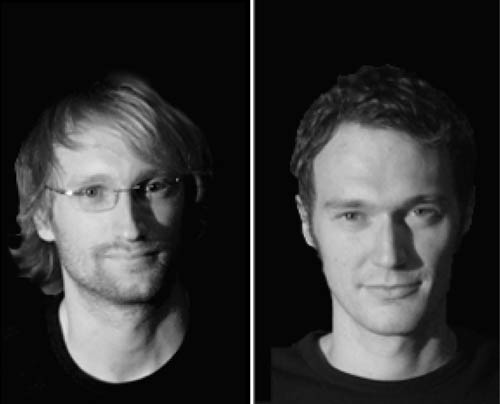Jörg Hugo and Jens Mehlan - Vienna Austria
February 2010 - Marina van den Bergen
In the 2005 edition of Archiprix International, the participants chose the Osaka Urban Station project as their favourite. Jens Mehlan and Jörg Hugo designed this grand scheme.
 Although you have never been in Japan, you chose Osaka as the location for your graduation project, a new railway station that connects five existing stations. How come?
Although you have never been in Japan, you chose Osaka as the location for your graduation project, a new railway station that connects five existing stations. How come?
Our graduation project was part of a larger research agenda into new urban geometries, an ongoing master course by Zaha Hadid. The Osaka Urban Station project is about design conditions; it is a study into prototypical development. How can you landscape the urban fabric by means of a new system of order so that it can comprise a high degree of organizational complexity within a single plane? Almost at the same time as we were making up a brief and looking for a generic site where we could apply our design tools, there was this real-life competition for the northern Osaka station area. We liked the brief and the location and didn't rate the entries too highly, so we chose to design an alternative. One other reason for choosing Osaka and not, say, Chicago was that a good friend of ours went to live in Osaka. He provided us with al the necessary data, such as public transport timetables, statistics, etc. Without this information, we could not have done our project.
You started your study in Aachen (Germany) but finished it in Vienna (Austria). Why did you change university?
At that time, the architectural department in Aachen was more interested in the application of state-of-the-art technology, whereas in Vienna it was more about the design process itself. However, although it might seem that Vienna is mostly about aesthetics, it is a very strict, experiment-driven process, perhaps more so than Aachen. It's about fundamentally rethinking architecture. For instance, Osaka is a very factual form, a form that is very much related to real data.
What did you do after you graduated?
We had the choice to move to London to work for Zaha, or stay in Vienna and work for Coop Himmelb(l)au, and teach at the university. We decided to stay in Vienna. In 2007, along with our life-long friend Christoph Opperer with whom we had already studied and worked, we officially started our own office, moh architects.
There are many examples of talented architects who start their offices and have to produce designs that are strongly influenced by the wishes of the client and their own financial dependence on the office. We don't want that happing to us. We don't want to be financially dependent on architectural projects.
Fortunately, we had the opportunity to teach at the university, for about 20 hours a week. And teaching gives us the opportunity to stay involved with fundamental design research. For example, at present the Zaha Hadid studio is doing research into parametric design strategies. Not only is the Vienna Studio doing this, but also her laboratory in the US and the UK. So you have this huge accumulation of information that results in these interesting designs. Teaching is very stimulating for our own development.
So which projects is your office working on right now? Have you actually built something?
No, we have not built anything yet, we are still in the competition phase. However, in November 2008, we actually won the competition for a 0.9 hectares of mixed-used waterfront development in Walsall (England) organized by the property developer Urban Splash. Then the crisis came and the design was put on hold, but we heard that the actual planning will start in June 2010.
The latest project we did was an open design competition for a 4-hectare business complex in the centre of Yerevan, Armenia. The winner would get a commission. We didn't win, but received an honourable mention.
What all our projects have in common is that the essence of the Osaka Urban Station project is still very much present in our work today; we always try to merge pure architectural design with real-life constraints.
Just to provoke you, how can you tell the difference between a project designed by Zaha Hadid and one designed by moh architects?
Do you really thing there is a major resemblance? Then you're not doing justice to Zaha's projects. Seriously though, what we do not understand is how you can fail to be influenced by your professor. If you have worked with somebody for four years, it will always have a visual impact. Looking at graduation projects from Aachen, you can also tell who the professor is. Somebody who graduated under Norman Foster, for example, will design a Foster-like project, we are sure about that. So our projects may have some superficial visual resemblance to Hadid's work, but it doesn't influence the originality of the projects themselves.
moh-architecture
Studio Zaha Hadid, University for Applied Arts Vienna
Moh Architects wins RIBA contest for Urban Splash’s Walsall waterfront regeneration - bdonline 25 November 2008

